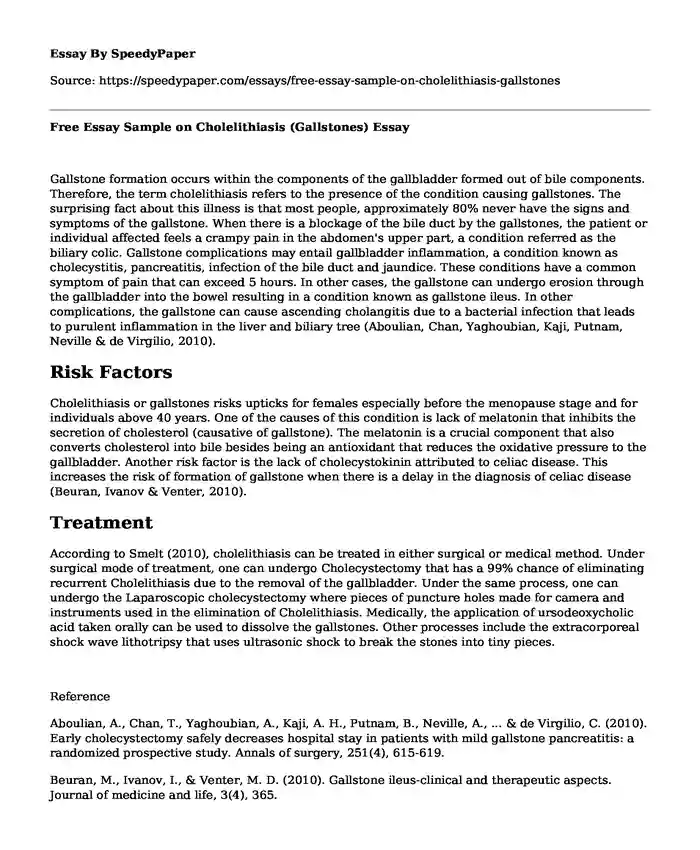Gallstone formation occurs within the components of the gallbladder formed out of bile components. Therefore, the term cholelithiasis refers to the presence of the condition causing gallstones. The surprising fact about this illness is that most people, approximately 80% never have the signs and symptoms of the gallstone. When there is a blockage of the bile duct by the gallstones, the patient or individual affected feels a crampy pain in the abdomen's upper part, a condition referred as the biliary colic. Gallstone complications may entail gallbladder inflammation, a condition known as cholecystitis, pancreatitis, infection of the bile duct and jaundice. These conditions have a common symptom of pain that can exceed 5 hours. In other cases, the gallstone can undergo erosion through the gallbladder into the bowel resulting in a condition known as gallstone ileus. In other complications, the gallstone can cause ascending cholangitis due to a bacterial infection that leads to purulent inflammation in the liver and biliary tree (Aboulian, Chan, Yaghoubian, Kaji, Putnam, Neville & de Virgilio, 2010).
Risk Factors
Cholelithiasis or gallstones risks upticks for females especially before the menopause stage and for individuals above 40 years. One of the causes of this condition is lack of melatonin that inhibits the secretion of cholesterol (causative of gallstone). The melatonin is a crucial component that also converts cholesterol into bile besides being an antioxidant that reduces the oxidative pressure to the gallbladder. Another risk factor is the lack of cholecystokinin attributed to celiac disease. This increases the risk of formation of gallstone when there is a delay in the diagnosis of celiac disease (Beuran, Ivanov & Venter, 2010).
Treatment
According to Smelt (2010), cholelithiasis can be treated in either surgical or medical method. Under surgical mode of treatment, one can undergo Cholecystectomy that has a 99% chance of eliminating recurrent Cholelithiasis due to the removal of the gallbladder. Under the same process, one can undergo the Laparoscopic cholecystectomy where pieces of puncture holes made for camera and instruments used in the elimination of Cholelithiasis. Medically, the application of ursodeoxycholic acid taken orally can be used to dissolve the gallstones. Other processes include the extracorporeal shock wave lithotripsy that uses ultrasonic shock to break the stones into tiny pieces.
Reference
Aboulian, A., Chan, T., Yaghoubian, A., Kaji, A. H., Putnam, B., Neville, A., ... & de Virgilio, C. (2010). Early cholecystectomy safely decreases hospital stay in patients with mild gallstone pancreatitis: a randomized prospective study. Annals of surgery, 251(4), 615-619.
Beuran, M., Ivanov, I., & Venter, M. D. (2010). Gallstone ileus-clinical and therapeutic aspects. Journal of medicine and life, 3(4), 365.
Smelt, A. H. M. (2010). Triglycerides and gallstone formation. Clinica Chimica Acta, 411(21-22), 1625-1631.
Cite this page
Free Essay Sample on Cholelithiasis (Gallstones). (2022, Jun 10). Retrieved from https://speedypaper.com/essays/free-essay-sample-on-cholelithiasis-gallstones
Request Removal
If you are the original author of this essay and no longer wish to have it published on the SpeedyPaper website, please click below to request its removal:
- Essay Example: Conversation vs. Speeches
- Free Essay on the Ethics of Social Media Accuracy
- Free Essay on Two General Ways that Psychologist Link Personality and Criminal Behavior
- Is the American Jury System Still a Good Idea? Law Essay Example
- Free Essay with Analysis of the Videos about Labour Unions
- Importance of Medication Adherence for Improved Health - Paper Sample
- Free Essay. Cancer Literature Review
Popular categories





